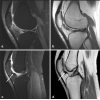A systematised MRI approach to evaluating the patellofemoral joint
- PMID: 20217407
- PMCID: PMC2919651
- DOI: 10.1007/s00256-010-0909-1
A systematised MRI approach to evaluating the patellofemoral joint
Abstract
Knee pain in young patients is a common indication for knee MRI. Many static and dynamic internal derangements of the patellofemoral joint in these patients lead to various secondary MRI findings. This article focuses on how to systematically approach, detect, and emphasize the importance of these findings in the diagnosis of patellofemoral tracking and impingement syndromes with relevant case examples.
Figures




















References
-
- Hungerford DS, Barry M. Biomechanics of the patellofemoral joint. Clin Orthop Relat Res. 1979;(144):9–15. - PubMed
-
- Faber SC, Eckstein F, Lukasz S, et al. Gender differences in knee joint cartilage thickness, volume and articular surface areas: assessment with quantitative three-dimensional MR imaging. Skeletal Radiol. 2001;30:144–50. - PubMed
-
- Fucentese SF, von Roll A, Koch PP, Epari DR, Fuchs B, Schottle PB. The patella morphology in trochlear dysplasia—a comparative MRI study. Knee. 2006;13:145–50. - PubMed
-
- Tecklenburg K, Dejour D, Hoser C, Fink C. Bony and cartilaginous anatomy of the patellofemoral joint. Knee Surg Sports Traumatol Arthrosc. 2006;14:235–40. - PubMed
-
- McNally EG, Ostlere SJ, Pal C, Phillips A, Reid H, Dodd C. Assessment of patellar maltracking using combined static and dynamic MRI. Eur Radiol. 2000;10:1051–5. - PubMed
Publication types
MeSH terms
Grants and funding
LinkOut - more resources
Full Text Sources
Medical

